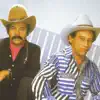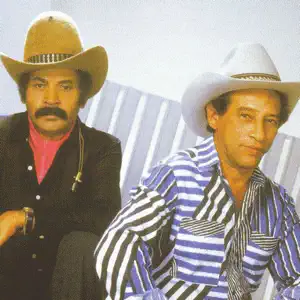


Acerca de Tião Carreiro & Pardinho
Known as one of the most important violeiros (viola players) of the "caipira" (hillbilly) universe, Tião Carreiro enjoyed (and still enjoys, to a lesser extent) national popularity in upcountry Brazil. His 28 78 rpm albums and his 57 singles and LPs are a good measure of his success. His partner for three decades was Pardinho, even though the incompatibility among them was notorious. For instance, they always rehearsed through recorded tapes, never together and they would meet only on-stage or in the studio. One of the all-time classics immortalized by the duo was "Rio de Lágrimas" (Tião Carreiro/Piraci/Lourival dos Santos), their biggest hit.
The son of a peasant, Carreiro had a poor childhood. After working all day in the fields, the eight-year-old would come in and play the viola. At 16, he formed the duo Palmeirinha e Coquerinho with Palmeirinha to perform in the local circus. With his cousin Valdomiro, he formed the duo Zezinho e Lenço Verde, which also performed on the radio in Valparaíso. In 1955, the duo broke up and the Irmãos Orlandino Circus came to Pirajuí, bringing Pardinho. The duo began to perform on Rádio Cultura and soon decided to depart for São Paulo. As Teddy Vieira's protégés, they recorded their first album in 1965 for Columbia: "Urutu Cruzeiro" (Paulo Calandro/Carreirinho) and "Resposta de Bombardeio" (Celso Duarte/Moacir dos Santos). They also recorded with other partners during that time because of strategies of the recording company. Carreiro recorded nine 78 rpm albums with Carreirinho (Adauto Ezequiel), some of them expressive pearls of this repertory. But it would be the duo with his partner Pardinho that would yield a popularity comparable to that enjoyed by Tonico e Tinoco. Their first hit was "Cavaleiro do Bom Jesus" (João Alves/Nhô Silva/Vieira), followed by "Boiadeiro Punho de Aço" (Vieira/Pereira). In that period, they worked at Rádio Tupi and then at Rádio Nacional. In 1959, they moved to Chantecler, and Palmeira became the company's A&R director. Some of their hits from that period were "Alma do Boêmio" (100,000 copies sold), "Borboleta do Asfalto," and "Punhal da Falsidade." The first LP (released in 1961) had "Rei do Gado" (Vieira), which remained one of the biggest classics of the genre. During the '60s and '70s, they came to record two LPs a year, with constant releases of collections. Carreiro, already celebrated for his instrumental playing and compositional talent, became known as the King of Pagode (nothing to do with its samba counterpart). Pagode was the name coined to describe the groove invented on the viola by Carreiro (which fused coco with calango de roda), with alternative tunings, and became popularized as a hillbilly genre. "Pagode em Brasília" (Vieira/Lourival dos Santos), one of the compositions in this genre, became a big hit and had several re-recordings (by Tião Carreiro e Pardinho in 1964, Irmãs Galvão, Inezita Barroso, and Roberto Corrêa, among others). "Rio de Piracicaba" (aka "Rio de Lágrimas," written by Piraci/Lourival/Carreiro) was another pagode that became a broadly popular classic, having been recorded by many a famous artist even today. One of the expressive tributes Carreiro received at the time was Capitão Furtado's lyrics for "A Beleza do Ponteio," dedicated to him (Carreiro would put music to the lyrics and record the song with Pardinho in 1969). In 1972, the duo appeared in the film Sertão em Festa, performing three songs from their repertory. In the mid-'70s, they were awarded the Villa-Lobos trophy from the Brazilian Association of Phonographic Producers. They were also given a Globo de Ouro special (prime-time national TV musical show) and won a gold record for their 29th LP, Rio de Pranto, but all of that didn't prevent the duo from splitting. The event gave Carreiro the opportunity to record an instrumental viola album that was the very first, É Isto Que o Povo Quer, which became anthological. The duo united again in 1981, recording six more albums and then dissolving again in 1986, this time forever. Carreiro continued to perform and record (also with Praiano, in the pop-sertanejo style) until his demise in 1993. ~ Alvaro Neder
The son of a peasant, Carreiro had a poor childhood. After working all day in the fields, the eight-year-old would come in and play the viola. At 16, he formed the duo Palmeirinha e Coquerinho with Palmeirinha to perform in the local circus. With his cousin Valdomiro, he formed the duo Zezinho e Lenço Verde, which also performed on the radio in Valparaíso. In 1955, the duo broke up and the Irmãos Orlandino Circus came to Pirajuí, bringing Pardinho. The duo began to perform on Rádio Cultura and soon decided to depart for São Paulo. As Teddy Vieira's protégés, they recorded their first album in 1965 for Columbia: "Urutu Cruzeiro" (Paulo Calandro/Carreirinho) and "Resposta de Bombardeio" (Celso Duarte/Moacir dos Santos). They also recorded with other partners during that time because of strategies of the recording company. Carreiro recorded nine 78 rpm albums with Carreirinho (Adauto Ezequiel), some of them expressive pearls of this repertory. But it would be the duo with his partner Pardinho that would yield a popularity comparable to that enjoyed by Tonico e Tinoco. Their first hit was "Cavaleiro do Bom Jesus" (João Alves/Nhô Silva/Vieira), followed by "Boiadeiro Punho de Aço" (Vieira/Pereira). In that period, they worked at Rádio Tupi and then at Rádio Nacional. In 1959, they moved to Chantecler, and Palmeira became the company's A&R director. Some of their hits from that period were "Alma do Boêmio" (100,000 copies sold), "Borboleta do Asfalto," and "Punhal da Falsidade." The first LP (released in 1961) had "Rei do Gado" (Vieira), which remained one of the biggest classics of the genre. During the '60s and '70s, they came to record two LPs a year, with constant releases of collections. Carreiro, already celebrated for his instrumental playing and compositional talent, became known as the King of Pagode (nothing to do with its samba counterpart). Pagode was the name coined to describe the groove invented on the viola by Carreiro (which fused coco with calango de roda), with alternative tunings, and became popularized as a hillbilly genre. "Pagode em Brasília" (Vieira/Lourival dos Santos), one of the compositions in this genre, became a big hit and had several re-recordings (by Tião Carreiro e Pardinho in 1964, Irmãs Galvão, Inezita Barroso, and Roberto Corrêa, among others). "Rio de Piracicaba" (aka "Rio de Lágrimas," written by Piraci/Lourival/Carreiro) was another pagode that became a broadly popular classic, having been recorded by many a famous artist even today. One of the expressive tributes Carreiro received at the time was Capitão Furtado's lyrics for "A Beleza do Ponteio," dedicated to him (Carreiro would put music to the lyrics and record the song with Pardinho in 1969). In 1972, the duo appeared in the film Sertão em Festa, performing three songs from their repertory. In the mid-'70s, they were awarded the Villa-Lobos trophy from the Brazilian Association of Phonographic Producers. They were also given a Globo de Ouro special (prime-time national TV musical show) and won a gold record for their 29th LP, Rio de Pranto, but all of that didn't prevent the duo from splitting. The event gave Carreiro the opportunity to record an instrumental viola album that was the very first, É Isto Que o Povo Quer, which became anthological. The duo united again in 1981, recording six more albums and then dissolving again in 1986, this time forever. Carreiro continued to perform and record (also with Praiano, in the pop-sertanejo style) until his demise in 1993. ~ Alvaro Neder
Canciones más vistas de
Tião Carreiro & Pardinho en Diciembre
Top Artistas
Nosotros
Notas
